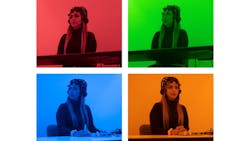Lighting designers, architects, and building owners often want to know which colors of light should be used to optimize the built environment for occupant wellbeing. Unfortunately, this question can be challenging because data supporting the use of specific colors of light for human health and wellbeing is limited.
The California Lighting Technology Center (CLTC) at the University of California, Davis, has joined forces with the Center for Mind and Brain, part of the UC Davis College of Letters and Science, to explore this important question in the world of human-centric lighting design. In 2022, the research team received initial funding to establish The Color Lab at UC Davis, building on its ongoing circadian lighting and hospital design efforts with UC Davis and UC Irvine. The Color Lab is equipped specifically for the exploration of the interactions between light, color, and human wellbeing — including a color testing chamber that is capable of creating any color in the CIE color space and delivering these color spectra to research participants.
Spectra under scrutiny
The CLTC and the Center for Mind and Brain are currently investigating the impact of discrete color spectra on stress, mood, and alertness. In the summer of 2022, Phase I of the study began to establish and validate the testing protocol. Research participants were given tasks to perform under a variety of lighting conditions. The investigators measured the participants’ responses using electroencephalography (EEG) and by testing cortisol levels. EEG is used to measure and record brain activity, while levels of the hormone cortisol in the body correlate with a person’s stress levels.
Study participants also answered survey questions related to their color preferences. The research team conducted these surveys and obtained EEG measurements and cortisol samples under varying color spectra, including red, green, blue, and amber light. The results were compared with measurements taken under the control condition: full-spectrum white light. The Color Lab utilizes a PureStyle RGBA lighting system in partnership with Color Kinetics, a Signify brand. With this dynamic, fully controllable LED lighting system, the researchers are able to deliver precise, high-quality color spectra to research participants.
Phase I results showed statistical significance for multiple colors, which the team declined to identify at this time. These spectra are currently being examined in Phase II, which started back in October and is now underway. In this current phase, 100 participants — mainly students from UC Davis — will take part for a statistically significant sample size. The researchers aim to obtain quantitative data to accurately ascertain the impact of specific color spectra on stress, mood, and alertness.
Funding the next phase
In October 2023 the CLTC announced a joint $200,000 contribution from Toyota Boshoku America and Seoul Semiconductor to support Phase II of this study. Long-term funding for the work done at CLTC is provided by private and public agencies, including the CLTC partners.
“We are grateful to Toyota Boshoku America and Seoul Semiconductor for their support to better understand the impact of light color on human psychology,” said Professor Jae Yong Suk, associate director of the CLTC. “This funding enables us to advance our research to the next level, bringing us closer to practical applications that can enhance the quality of life for people everywhere.”
“We are excited about the possibilities this partnership opens up and are committed to delivering results that resonate beyond academia,” said Professor Michael Siminovitch, CLTC director. “Insights gained from this study have the potential to help advance lighting design principles, leading to the creation of healthier, more comfortable living and working environments.”
Other CLTC research projects in this area include an ongoing partnership with the UC Davis Medical Center to gain insight into how discrete colors can be utilized to reduce patient stress levels during high-stress medical procedures, including cancer treatments, surgery, radiology, and medical imaging. The research team is closely collaborating with the UC Davis Medical Center and the UC Irvine Medical Center for beta testing the strategies in their respective hospitals.
The CLTC and the Center for Mind and Brain are also collaborating with the Betty Irene Moore School of Nursing and the College of Biological Sciences, both at UC Davis, on the circadian implications related to lighting and color from the UC Davis Circadian Protocol. The UC Davis Circadian Protocol focuses on how to design lighting for healthcare settings to make the most of the natural 24-hour rhythm that affects human physical, mental, and behavioral changes. In simpler terms, it recommends ways to use lighting to promote overall wellbeing, help our eyes adjust to darkness, and create high-quality visual environments for patients and staff alike. This protocol helped inform the lighting design of the UC Davis and UC Irvine hospitals and research is now looking at how the protocol can be applied to nursing stations. The protocol was initially funded by the Sacramento Municipal Utility District (SMUD) and the Electric Program Investment Charge (EPIC) Program at the California Energy Commission.
The CLTC is a not-for-profit research, development, and demonstration facility dedicated to accelerating the development and commercialization of electric building systems and controls technology in pursuit of decarbonization, grid resiliency, and community wellbeing.
Potential applications for light color research
Automotive interior lighting design
Improving patient wellbeing in sensitive care units, such as the NICU
Enhanced visual acuity and comfort for clinical/surgical teams
REBEKAH MULLANEY is a freelance writer and editor with more than 20 years of experience. She has worked in public relations, marketing, and editorial roles for Rensselaer Polytechnic Institute (RPI), the Naval Nuclear Laboratory, and Albany Molecular Research. She has a B.A. in English from Kalamazoo College and an M.S. in communications from RPI.
Follow our LinkedIn page for our latest news updates, contributed articles, and commentary, and our Facebook page for events announcements and more. You can also find us on the X platform.





